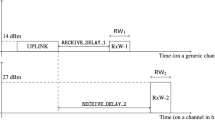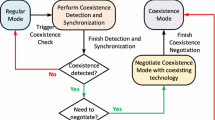Abstract
Within realization of the visions of the Internet-of-Things (IoT), Low Power Wide Area Networks (LPWANs) are undoubtedly one of the fields that attract high interest from both academic and industrial fields. To ensure reliable data exchange between low power and low data rate devices across long distances, which are the main aims of LPWAs, it is necessary to utilize advanced wireless communication technologies. Emerging LPWA technologies, for instance Long-Range (LoRa) and SigFox, offer many benefits for IoT. These technologies have been primarily developed for sub-GHz frequency bands, but, in the future, their deployment is also considered in the 2.4 GHz industrial, scientific and medical (ISM) bands. However, these unlicensed ISM bands are also used by other technologies for Wireless Local Area Network (WLAN also denoted as Wi-Fi) connectivity and other services, and therefore, coexistence issues can occur here in the future. The main aim of this paper is to perform a performance analysis of the LoRa radio signals interfered by Wi-Fi, using interferers confirming to different IEEE 802.11 family standards, in the 2.4 GHz ISM band. For this purpose, an automated measurement setup and methodology on Physical (PHY) layer are proposed and used. In general, the evaluated results confirm theoretical assumptions on high robustness of LoRa against interferences. However, our results reveal that this robustness of LoRa is highly depending not only on the used LoRa system parameters, but also on the interferer properties and the assumed coexistence scenarios (co-channel, in-band and adjacent channel interferences).










Similar content being viewed by others
Notes
\(\hbox {LoRaWAN}^{TM}\) Specifications, V1.0; LoRa Alliance.
References
Goudos, S. K., Dallas, P. I., Chatziefthymiou, S., & Kyriazakos, S. (2017). A survey of IoT key enabling and future technologies: 5G, mobile IoT, sematic web and applications. Wireless Personal Communications, 97(2), 1645–1675.
Raza, U., Kulkarni, P., & Sooriyabandara, M. (2017). Low power wide area networks: An overview. IEEE Communications Surveys and Tutorials, 19(2), 855–873.
Augustin, A., Yi, J., Clausen, T., & Townsley, W. M. (2016). A study of LoRa: Long range & low power networks for the Internet of Things. Sensors, 16(9), 1–18.
LoRa Aliance. (2015). \(\text{LoRaWAN}^{TM}\) What is it? A technical overview of \(\text{ LoRa }^{\textregistered }\) and \(\text{ LoRaWAN }^{TM}\). https://lora-alliance.org/resource-hub/what-lorawanr. Accessed 22 October 2019.
Noreen, U., Bounceur, A., & Clavier, L. (2017). A study of LoRa low power and wide area network technology. In Int. conf. ATSIP, Fez, Morocco (pp. 1–6).
Jebril, A. H., Sali, A., Ismail, A., & Rasid, M. F. A. (2018). Overcoming limitations of LoRa physical layer in image transmission. Sensors, 18(10), 1–22.
Petajajarvi, J., et al. (2017). Performance of a low-power wide-area network based on LoRa technology: Doppler robustness, scalability, and coverage. International Journal of Distributed Sensor Networks, 13(3), 1–16.
Haxhibeqir, J., Van den Abeele, F., Moerman, I., & Hoebeke, J. (2017). LoRa scalability: A simulation model based on interference measurements. Sensors, 17(6), 1–25.
Adelantado, F., et al. (2017). Understanding the limits of LoRaWAN. IEEE Communications Magazine, 55(9), 34–40.
Bor, M., & Roedig, U. (2017). LoRa transmission parameter selection. In Int. conf. DCOSS, Ottawa, ON, Canada (pp. 27–34).
Croce, D., et al. (2018). Impact of LoRa imperfect orthogonality: Analysis of link-level performance. IEEE Communications Letters, 22(4), 796–799.
Carlsson, A., Kuzminykh, L., Franksson, R., & Liljegren, A. (2018). Measuring a LoRa network: Performance, possibilities and limitations. In Int. conf. NEW2AN 2018 and ruSMART 2018, St. Petersburg, Russia (pp. 116–128).
Ayele, E. D., et al. (2017). Performance analysis of LoRa radio for an indoor IoT applications. In Int. conf. IoTGC), Funchal, Portugal (pp. 1–6).
Poorter, E. D., et al. (2017). Sub-GHz LPWAN network coexistence, management and virtualization: An overview and open research challenges. Wireless Personal Communications, 95(1), 187–213.
Reynders, B., Meert, W., & Pollin, S. (2016). Range and coexistence analysis of long range unlicensed communication. In Proc. of int. conf. ICT, Thessaloniki, Greece (pp. 1–6).
Vejlgaard, B., et al. (2017). Interference impact on coverage and capacity for low power wide area IoT networks. Proc. of int. conf. WCNC (pp. 1–6).
Lauridsen, M., et al. (2017). Interference measurements in the European 868 MHz ISM band with focus on LoRa and SigFox. In Proc. of int. conf. WCNC (pp. 1–6).
Mikhaylov, K., Petajajarvi, J., & Janhunen, J. (2017). On LoRaWAN scalability: Empirical evaluation of susceptibility to inter-network interference. In Proc. of int. conf. EuCNC, Oulu, Finland (pp. 1–7).
Haxhibeqir, J., Shahid, A., Saelens, M., & Bauwens, J. (2018). Sub-gigahertz inter-technology interference. How harmful is it for LoRa? In 4th IEEE int. conf. ISC2, Kansas City, Missouri, USA (pp. 1–7).
Orfanidis, Ch., Feeney, L. M., Jacobsson, M., & Gunningberg, P. (2017). Investigating interference between LoRa and IEEE 802.15.4g networks. In IEEE int. conf. WiMob, Rome, Italy (pp. 1–8).
Vangelista, L., Zanella, A., & Zorzi, M. (2015). Long-range IoT technologies: The eawn of \(\text{ LoRa }^{TM}\). In Proc. of int. conf. FABULOUS 2015, Ohrid, Republic of Macedonia (pp. 51–58).
Wendt, T., Volk, F., & Mackensen, E. (2015). A benchmark survey of long range (LoRaTM) spread-spectrum-communication at 2.45 GHz for safety applications. In Proc. of int. conf. WAMICON, Cocoa Beach, FL, USA (pp. 1–4).
Semtech. (2017). Application note: Wi-Fi immunity of \(\text{ LoRa }^{\textregistered }\) at 2.4 GHz. Semtech application note, long range, low power 2.4 GHz transceiver (pp. 1–20).
Semtech. (2017). An introduction to ranging with the SX1280 transceiver. Application Note, AN1200.29 (pp. 1–30).
IMST. (2018). iM282A—high range with \(\text{ LoRa }^{\textregistered }\) on worldwide 2.4 GHz band. https://wireless-solutions.de/news/208-lora-im282a-high-range-with-lora-on-worldwide-2-4ghz-band,-11-2018.html. Accessed 14 February 2019.
Mikulka, J., & Hanus, S. (2008). Bluetooth and IEEE 802.11b/g coexistence simulation. Radioengineering, 17(3), 66–73.
Shi, T., Chen, X., & Sha, M. (2015). Enabling direct messaging from LoRa to ZigBee in the 2.4 GHz band for industrial wireless networks (pp. 1–10). https://pdfs.semanticscholar.org/992b/029f915d73114541045e027cde71546871e3.pdf. Accessed 22 January 2020.
Baronti, P., et al. (2007). Wireless sensor networks: A survey on the state of the art and the 802.15.4 and ZigBee standards. Computer Communications, 30(7), 1655–1695.
Milos, J., Polak, L., Slanina, M., & Kratochvil, T. (2016). Link-level simulator for WLAN networks. In Proc. of int. workshop (\(\text{ IWSLS } ^{2}\)), Vienna, Austria (pp. 1–4).
RevSpace. (2019). Decoding Lora. https://revspace.nl/DecodingLora. Accessed 22 October 2019.
Knight, M. (2019). Reversing LoRa—exploring next-generation wireless. https://www.scribd.com/document/385446002/Reversing-Lora-Knight. Accessed 22 October 2019.
Noreen, U., Clavier, L., & Bounceur, A. (2018). LoRa-like CSS-based PHY layer, capture effect and serial interference cancellation. In Int. conf. Europen wireless, Catania, Italy (pp. 68–73).
Olsson, K., & Finnsson, S. (2017). Exploring LoRa and LoRaWAN—a suitable protocol for IoT weather stations? Master’s thesis in communication engineering, 84 pages.
Popescu, V., Fadda, M., & Murroni, M. (2016). Performance analysis of IEEE 802.22 wireless regional area network in the presence of digital video broadcasting—second generation terrestrial broadcasting services. IET Communications, 10(8), 922–928.
Tekovic, A., Bonefacic, D., Sisul, G., & Nad, R. (2017). Interference analysis between mobile radio and digital terrestrial television in the digital dividend spectrum. Radioengineering, 26(1), 211–220.
Klozar, L., Polak, L., Kaller, O., & Prokopec, J. (2013). Effect of co-existence interferences on QoS of HSPA/WCDMA mobile networks. In Proc. of int. conf. Radioelektronika, Pardubice, Czech Republic (pp. 312–315).
Milos, J., Polak, L., & Rozum, S. (2019). Analysis of indoor LTE-DL/Wi-Fi coexistence scenarios with automated measurement testbed. In Proc. of int. conf. Radioelektronika, Pardubice, Czech Republic (pp. 308–312).
R&S. (2014). R&S FSQ signal analyzer. Operating manual, R&S (847 pages).
National Instruments. Introduction to wireless LAN measurements from 802.11a to 802.11ac. Technical Documentation, National Instruments (42 pages).
Tektronix. (2013). Wi-Fi: Overview of the 802.11 physical layer and transmitter measurements. Technical Documentation, Tektronix, Primer (44 pages).
ETSI EN 300 328. (2017). Wideband transmission systems; data transmission equipment operating in the 2.4 GHz ISM band and using wide band modulation techniques; Harmonised Standard for access to radio spectrum. ETSI, Draft, V2.2.0 (105 pages).
Guizar, A., Ochoa, M. N., Mannoni, V., & Maman, M. (2019). LPWA deployment for factory of the future: LoRa or Turbo-FSK based technology? In Proc. of int. Ssmp. PIMRC, Istanbul, Turkey (pp. 1–6).
Acknowledgements
This work was supported by the Ministry of Education, Youth and Sports (MEYS) of the Czech Republic Project No. LTC18021 (FEWERCON).
Author information
Authors and Affiliations
Corresponding author
Ethics declarations
Conflict of interest
On behalf of all authors, the corresponding author states that there is no conflict of interest.
Additional information
Publisher's Note
Springer Nature remains neutral with regard to jurisdictional claims in published maps and institutional affiliations.
Rights and permissions
About this article
Cite this article
Polak, L., Milos, J. Performance analysis of LoRa in the 2.4 GHz ISM band: coexistence issues with Wi-Fi. Telecommun Syst 74, 299–309 (2020). https://doi.org/10.1007/s11235-020-00658-w
Published:
Issue Date:
DOI: https://doi.org/10.1007/s11235-020-00658-w




